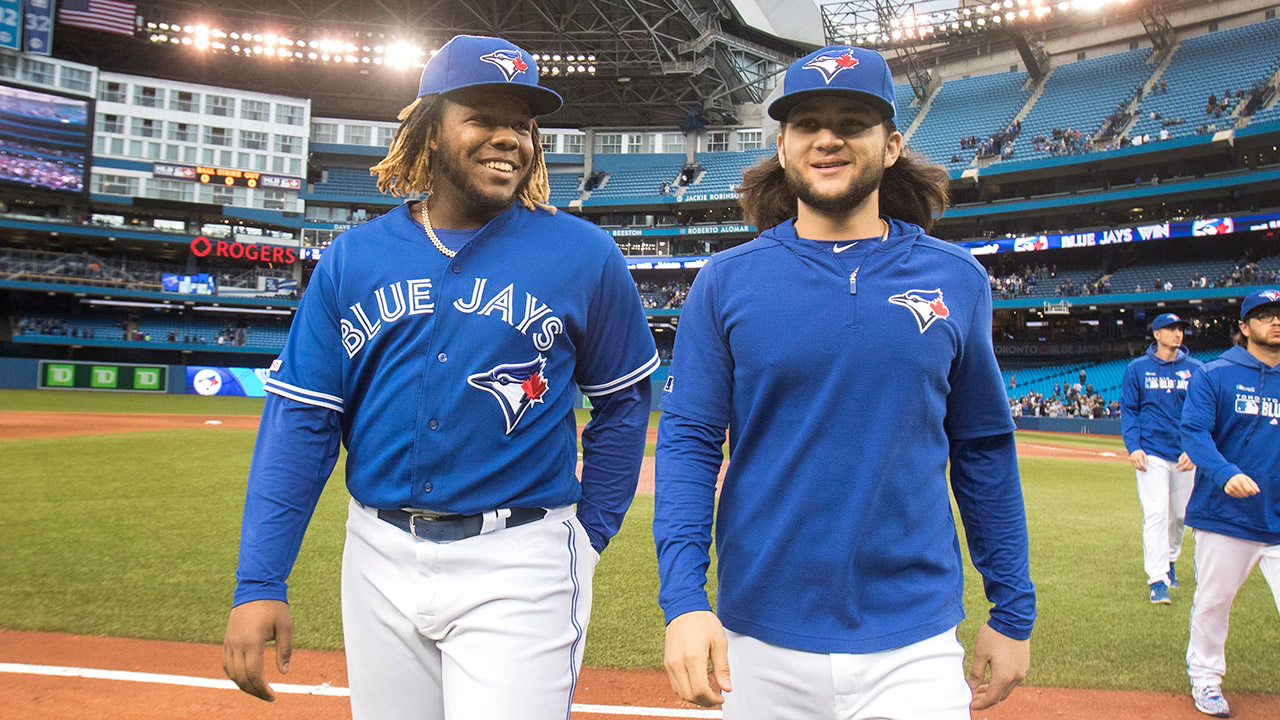While the Toronto Blue Jays have built themselves a credible rotation around Hyun-Jin Ryu this off-season, the team’s main attraction has never wavered.
Barring some unlikely play for Francisco Lindor, Mookie Betts, or Nolan Arenado, the most compelling reason for optimism about this team’s outlook continues to be the young core of Vladimir Guerrero Jr., Bo Bichette and Cavan Biggio. That’s this team’s “Big Three” or as Scott Boras put it recently, the “Royal Youth Uprising.”
There’s a reason that trio appeared to unveil the club’s new jersey at Winter Fest (along with Randal Grichuk, whose $52-million extension and suitability to model just about anything punched him a ticket onto the stage).
While there’s likely plenty of team building to come before the Blue Jays can field a true contender — and another possible homegrown star in Nate Pearson coming down the pipe shortly — the club’s sophomore studs will determine how far this team goes. A resurgent offensive performance from Danny Jansen or another step forward from Lourdes Gurriel Jr. could challenge their status as the core of Toronto’s lineup, but the smart money is on them being the team’s top three position players for the foreseeable future — especially since the club’s best hitting prospect — Jordan Groshans — finished last season at Class-A Lansing.
That’s not the worst place to be considering the impressive debuts of Bo and Biggio plus the raw talent of Vladdy. However, it does invite the question of just how good these three have to be for the Blue Jays to be competitive.
[snippet id=4722869]
As it stands, Guerrero Jr., Bichette and Biggio are projected by Steamer to combine for 9.3 wins above replacement in 2020. There’s an argument to be made that all three are possible projection busters, but that number includes generous assumptions about Vladdy improving his defence and baserunning that skew it relatively optimistic for him in particular. The projection is not perfect, but it’s a solid baseline.
So, how many teams make the playoffs when their top three players combine for 9.3 WAR?
As it turns out, just one out of 80 (or 1.25 percent) since the addition of the wildcard game in 2012. The 2015 New York Yankees had Didi Gregorius, Mark Teixeira, and Brian McCann combine for 8.8 WAR on the way to an 87-win season that earned them a shot at the Houston Astros in the wild-card game (they lost 3-0)
If the Blue Jays manage to break through this season, it will probably look something like that Yankees team which was solid, but unspectacular (10th in position player and pitcher WAR) and had surprisingly low win totals to chase.
More instructive for Toronto’s purposes are the other 79 teams that reached the post-season in the last eight years. What was the standard their top trios had to meet?
As it happens, that benchmark has been awfully consistent:
| Season | Playoff Teams’ Average “Big Three” WAR |
|---|---|
| 2012 | 14.5 |
| 2013 | 14.6 |
| 2014 | 14.2 |
| 2015 | 13.1 |
| 2016 | 14.6 |
| 2017 | 14.1 |
| 2018 | 15.5 |
| 2019 | 14.7 |
| Total | 14.4 |
It’s remarkable how little this number has moved in eight seasons, apart from two anomalous years.
In 2015, there was a lack of dominant teams and four of the playoff-bound squads won 90 or fewer games. Only four teams of that quality played for the World Series in 2017, 2018 and 2019 combined. Perhaps unsurprisingly, the Blue Jays’ trio of Josh Donaldson, Jose Bautista and Edwin Encarnacion put up the highest WAR total of any club’s top three position players at 18.4.
Three years later the exact opposite occurred, particularly in the American League where the five playoff squads combined for 499 wins. The two highest “Big Three” WAR totals both came from that season as the World Series-winning Boston Red Sox got an astounding 21.2 WAR out of Mookie Betts, J.D. Martinez and Xander Bogaerts while Jose Ramiez, Francisco Lindor and Michael Brantley gave Cleveland 19.1 WAR.
Besides those two campaigns, teams entering the playoffs have generally averaged just under 15 WAR from the best third of their lineup.
Of course, getting that level of production from your best three players is no guarantee of playoff glory. The Los Angeles Angels are a perfect example of a team who — thanks almost exclusively to Mike Trout — have consistently gotten elite “Big Three” production but failed to escape mediocrity.
| Season | Angels’ “Big Three” WAR | Playoff Team’s Average “Big Three” WAR | Difference |
|---|---|---|---|
| 2012 | 19.3 | 14.5 | 4.8 |
| 2013 | 15 | 14.6 | 0.4 |
| 2014 | 17.1 | 14.2 | 2.9 |
| 2015 | 14.8 | 13.1 | 1.7 |
| 2016 | 15.9 | 14.6 | 1.3 |
| 2017 | 14.9 | 14.1 | 0.8 |
| 2018 | 18.3 | 15.5 | 2.8 |
| 2019 | 14.5 | 14.7 | -0.2 |
Constructing a contending team takes more than acquiring a handful of elite position players. It’s handy to have a pitching staff for instance — as anyone who watched the 2019 Blue Jays will attest. Even if Guerrero Jr., Bichette and Biggio all blossom into true stars GM Ross Atkins still has plenty of work to do.
That said, the starting point of building a playoff squad is that core. Right now it seems unlikely the Blue Jays’ top trio is ready to elevate them into the mix. There’s no shortage of room to grow for the “Royal Youth Uprising,” but there’s likely a long way to go before they’re the sort of group you can build a champion around.
[relatedlinks]









